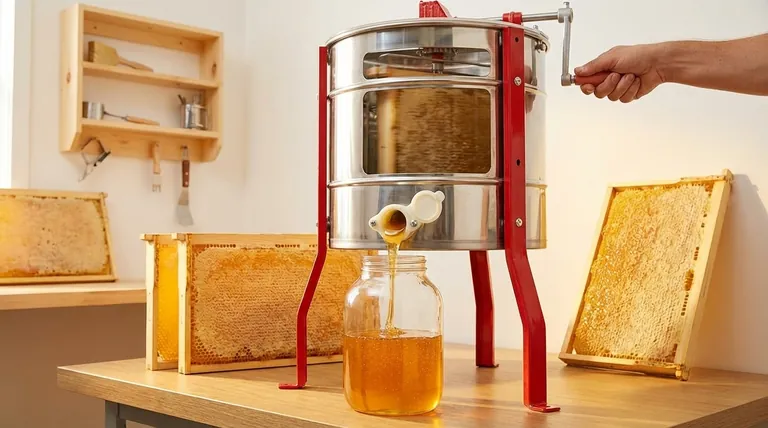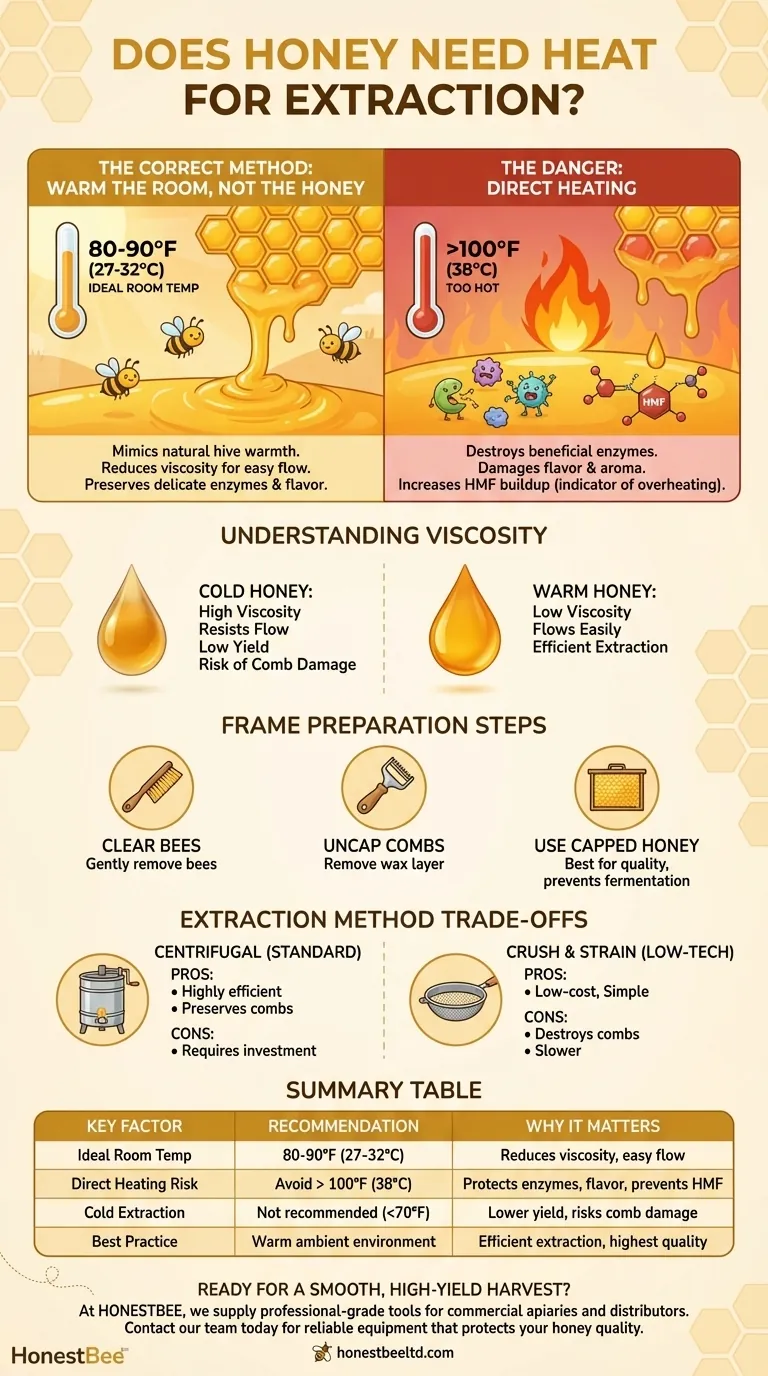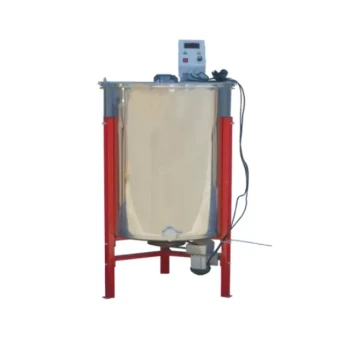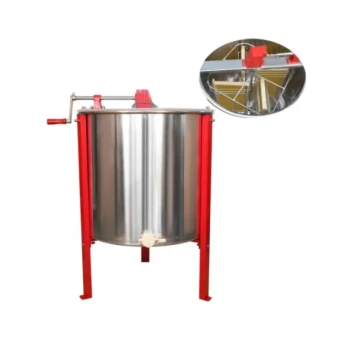No, honey does not need to be directly heated before extraction. The goal is to warm the ambient environment where you are working, not the honey itself. An ideal room temperature of 80-90°F (27-32°C) makes the honey less viscous and allows it to flow easily from the combs, but it is not an absolute requirement for the process.
The core principle is not to heat the honey, but to warm the room. This lowers the honey's viscosity, mimicking the natural warmth of the hive and allowing for an efficient extraction without damaging the honey's delicate enzymes and flavor.

The Role of Temperature in Honey Extraction
Understanding why temperature matters is the key to a successful harvest. Honey's consistency is highly dependent on its temperature.
Why Warmth Matters: Viscosity
Honey is naturally viscous, meaning it resists flowing. When honey is cold, it becomes thick and stubborn, almost like molasses.
Warming the room where you extract heats the frames and the honey within them. This reduces the honey's viscosity, making it flow more like a thin syrup, which is essential for getting it out of the comb.
The Ideal Temperature Range
The target temperature for your extraction space is 80-90°F (27-32°C).
This range closely matches the internal temperature of a bustling beehive. Working in this warmth allows the honey to flow freely when spun in an extractor or strained.
What Happens if it's Too Cold?
Extracting in a cold room (below 70°F or 21°C) leads to several problems. The honey will be too thick to exit the cells properly, resulting in a significantly lower yield.
You may also be forced to spin the extractor faster or for longer, which increases the risk of damaging or "blowing out" the delicate wax combs.
The Dangers of Direct Heating
It is critical to distinguish between warming the room and directly heating the honey.
Preserving Honey Quality
Directly heating honey frames or liquid honey, especially above 100°F (38°C), begins to destroy the beneficial enzymes and volatile compounds that give honey its unique flavor and aroma.
Avoiding HMF Buildup
Excessive heat also increases the levels of Hydroxymethylfurfural (HMF), an organic compound formed when sugars are heated. While not dangerous in small amounts, high HMF levels are an indicator of overheating and poor quality honey. Commercial "heating tanks" are used to liquefy crystallized honey, not for initial extraction.
A Step-by-Step Guide to Frame Preparation
A smooth extraction day starts with proper preparation. Ensure your extraction space is clean, sealed from bees, and ideally, warmed ahead of time.
1. Clear the Bees from the Frames
Before bringing frames indoors, you must remove the bees. This is typically done with a soft bee brush to gently sweep them off or by using a fume board or bee escape board 24 hours prior.
2. Uncap the Combs
Bees seal their finished honey with a layer of wax. This must be removed. Use an uncapping tool like a heated electric knife, a cold uncapping knife, or an uncapping fork (scratcher) to slice or scrape off this top layer of wax.
3. Use Fully Capped Honey
For the best results, only extract from frames where the honey is fully "capped" with wax. Uncapped honey has a higher moisture content, which can cause it to ferment and spoil during storage.
Understanding Extraction Method Trade-offs
Your choice of extraction method depends on your budget, scale, and goals.
Centrifugal Extraction (The Standard)
This method uses a manual or motorized honey extractor that spins the frames. Centrifugal force flings the honey out of the cells and onto the walls of the tank, where it drains to the bottom.
- Pros: Highly efficient, fast, and preserves the wax combs, which can be returned to the bees.
- Cons: Requires a significant investment in specialized equipment.
Crush and Strain (The Low-Tech Method)
This involves cutting the comb out of the frame, mashing it up in a bucket, and pouring the mixture through a sieve or cheesecloth to separate the honey from the wax.
- Pros: Requires minimal equipment and is very low-cost.
- Cons: Destroys the comb, forcing the bees to expend significant energy to rebuild it. It is also slower and often messier.
Making the Right Choice for Your Harvest
Your primary goal will determine your ideal approach to extraction.
- If your primary focus is efficiency and preserving combs: Use a centrifugal extractor in a room pre-warmed to 80-90°F and only use fully capped frames.
- If your primary focus is low cost and simplicity: Use the crush-and-strain method, but accept that you are sacrificing the wax comb for future use.
- If your primary focus is honey quality: Never apply direct heat to your frames or honey and maintain a meticulously clean workspace to prevent any contamination.
Ultimately, a successful extraction is about working with the honey's natural properties, not against them.
Summary Table:
| Key Factor | Recommendation | Why It Matters |
|---|---|---|
| Ideal Room Temperature | 80-90°F (27-32°C) | Reduces honey's viscosity for easy flow, mimicking the hive's natural warmth. |
| Direct Heating Risk | Avoid above 100°F (38°C) | Protects delicate enzymes, flavor, and prevents HMF buildup. |
| Extraction in Cold Room | Not recommended (Below 70°F / 21°C) | Leads to lower yield and risks damaging wax combs. |
| Best Practice | Warm the ambient environment | Ensures efficient extraction while preserving the highest honey quality. |
Ready for a smooth, high-yield honey harvest?
At HONESTBEE, we supply commercial apiaries and beekeeping equipment distributors with the professional-grade tools needed for success. From durable honey extractors to precise uncapping knives, our wholesale-focused operations ensure you get reliable equipment that protects your honey's quality and maximizes your efficiency.
Let's discuss your specific needs. Contact our team today to find the right solutions for your operation.
Visual Guide

Related Products
- 2 Frame Stainless Steel Manual Honey Spinner Extractor for Beekeeping
- Electric 8 Frame Honey Spinner Extractor Equipment for Beekeeping
- HONESTBEE 72 Frame Industrial Electric Honey Extractor for Beekeeping
- HONESTBEE 6 Frame Self Reversing Electric Honey Extractor for Beekeeping
- 8-Frame Electric Self-Reversing Honey Extractor Spinner for Commercial Honey Extraction Equipment
People Also Ask
- What are some tips for using a honey extractor effectively? Maximize Your Honey Yield and Protect Your Comb
- Can a manual extractor be upgraded to an electric one? Save Labor & Boost Efficiency
- What are some expert tips for cleaning a honey extractor? Protect Your Harvest & Equipment
- How does centrifugation work in honey extraction? The Sustainable Method for Modern Beekeepers
- What mistakes should be avoided during honey extraction with a centrifuge? Preserve Your Comb and Honey Quality



















